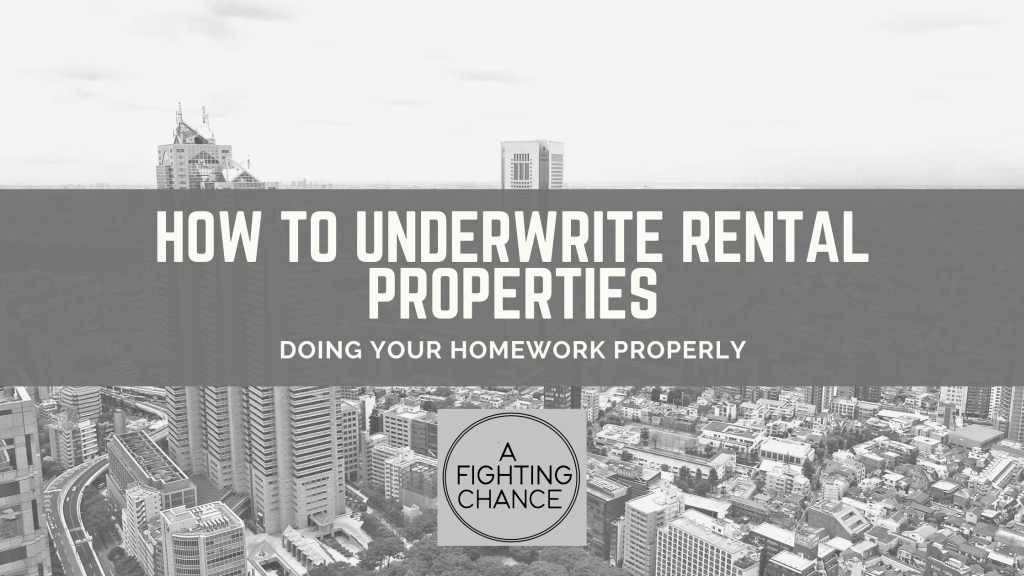What is underwriting? It’s pretty simple. Homework. Due Diligence. Checking on things. Its a fancy word for an straightforward process. Doing due diligence is important on any investment, although I would argue it is most important when it comes to real estate because of the fact that the investment is typically leveraged.
What is leveraged? This means that it involves borrowing money to acquire the asset. Whenever you borrow money to buy an asset, the lender takes less risk than you do. If something goes bad with the investment and you have to sell the property at a loss, the bank gets paid back first and only if there is anything left do you “the equity investor” get your money back.
Therefore, you want to be very confident that things won’t go bad and you won’t lose money. Nothing is a certainty – there is always risk to any investment decision – but here is how to manage the risk and make the decision on an educated basis.

Asset financial performance expectations
The most important part of any investment is answering the question “how much money am I going to make?” Start with running your own financial model on the investment.
Income
Start with revenues you expect. How much do similar properties rent for? Go check rental websites and see what kind of rent you can expect each year. Don’t overshoot on these expectations – the rental market can be volatile and in economic down cycles rents can drop by 20-30%. While this is rare, in underwriting it is important to be conservative so that your asset surprises you to the upside, not the downside.
Let’s frame up a sample property here which we are looking to acquire for $300,000. The market is telling us that similar properties are renting for $1,500 per month. We’re going to factor in a vacancy / conservatism factor of 5%, because the market has a 5% vacancy rate and it might take us a few months to identify a tenant during lease up and during periods where tenants turnover. Therefore we want to understand the gaps in cash flow which will inevitably occur, and how we can afford them. So we will use $1,350 for our rental expectations.
Expenses
Rental properties come with a plethora of different expenses. These need to be studied as well to make sure you understand the full picture of how much income the property will generate after costs. The most common expenses are as follows:
Strata / Homeowners dues – We will assume $125 per month
Insurance – We will assume $50 per month (paid once per year, but important to amortize over the whole year)
Mortgage Principal and Interest (a $240k mortgage (80% of $300k cost) at a 2% interest rate over a 30 year amortization costs $887 per month)
Property Taxes (We will assume $250 per month. Again likely paid once or twice per year)
Repairs and Maintenance (Let’s assume $25 per month)
Property Management Fees and leasing commissions (Usually 10% of rent for property management and first months rent for leasing, so we’ll assume $135 per month)
So, the net income after all these expenses is $13 per month. $150 per year in cash flow seems low on a $60,000 equity investment in a $300,000 property at first glance. But let’s also look at the other forms of returns on a rental property.
Principal pay down
That $887 you paid above includes principal and interest paid to the bank. Interest is simple – it’s the bank’s profit on lending you their money. Principal is your slow repayment of their money over the life of the mortgage. As the principal gets repaid and the outstanding loan gets smaller, the interest on the loan gets smaller. So therefore, even though the payment remains the same every year, the percentage which goes to principal grows over time. In month 1, of the $887, $487 goes to principal repayment. Over the first year, you’ll repay almost $5,900 of the loan. This is almost a 10% return on equity. It actually exceeds 10% once you add in the cash flow.
Appreciation
The beauty of using bank money to acquire an asset is that if the asset goes up in value, you the equity investor accrue all of the appreciation. The bank only ever gets their interest expense. Therefore, if the $300,000 goes up by 1% per year, or $3,000, that all goes to you and is a return on your $60,000 investment of 5%. I usually underwrite something conservative for appreciation like 1-2% because otherwise the investment can look juicier than it is. But even if you underwrite a 2% appreciation rate on an investment which is 80% funded by bank debt, it means a 10% rate of return on your equity.
TOTAL
So with cash flow, principal reduction and appreciation, this investment looks to be returning us as the equity investor about 20%. That is a pretty solid return, especially considering that the tax code allows us to take a depreciation expense on the value of the building which generally reduces our taxable income from the property to near zero while we own the property. When we sell, that depreciation gets “recaptured” by the government, but its a wonderful deferral of taxes if you hold the property over the long run, which I like to do.
Assess your risks
Even though you’ve now projected out how you think the asset will perform, there is always a chance that things won’t work out the way you expect them to. It’s important to consider the many risks that come with investing in real estate, so that you can decide whether you think the returns are worth those risks, and identify ways to mitigate them.
In real estate investing, the most common risks are as follows:
- Interest Rate Risk – What if the rate on my mortgage goes up and the income from the property isn’t sufficient to pay my debt coverage anymore? Interest rates rising also have a negative impact on real estate values in general.
- Liability Risk – What if a tenant, vendor or property manager comes onto the property, slips and falls, and then sues me?
- Damage Risk – What if a tenant wrecks the property?
- Fire Risk – What if a fire burns down the building?
- Cap Rate Risk – tied somewhat with interest rate risk, what if cap rates for my asset class rise, causing the price of my investment to fall?
- Vacancy Risk – What if my tenant leaves and I have no more income coming in to pay for expenses?
- Market Risk – What if jobs disappear around my property or the economy goes through a rough patch, or desirability of my asset declines and prices of properties around mine begin to fall?
- Political and government risk – What if City Council, or any other political body whether it be local, state or federal, impose new levies or taxes which reduce the cash flow from my property?
- Repair Risk – What if the roof starts to leak, or the property needs a new boiler or the foundation starts cracking? Do a property inspection to make sure that there aren’t any glaring cost risks to you as a new buyer, and if there are make sure you factor them into the price you’re willing to pay. If the property is a strata, make sure the strata corporation has adequate reserve funds to pay for repairs. If they don’t you could be on the hook for a special assessment when a big cost becomes necessary.
Some of these risks can be mitigated with insurance and homework. Others can’t. The properties with the higher risks should come with higher rates of return. This is why apartments in Seattle have a 4% cap rate (very expensive) and apartments in mid-west USA have an 8% cap rate (very cheap). One has huge employment centers, growth, high incomes and is almost a sure thing. The other is the opposite.
Pulling the trigger
Once you have satisfied yourself that your returns are adequate to compensate you for the risks you are taking on, it’s time to make the purchase decision. Every real estate deal is negotiable on both price and terms. For example, you might be willing to pay full asking price, but you want to have 90 days to close to really do some in depth studies. Or perhaps you’re ready to close in 30 days and have the cash ready, so you want a reduction in price.
Like with every other aspect of underwriting, do your homework on the values of comparable properties around the neighborhood and look at statistics on the property itself like price per square foot, year constructed, property tax assessed value or any other statistic which gives you comfort that you aren’t overpaying. They say that in real estate, you make money when you buy right.


Leave a comment